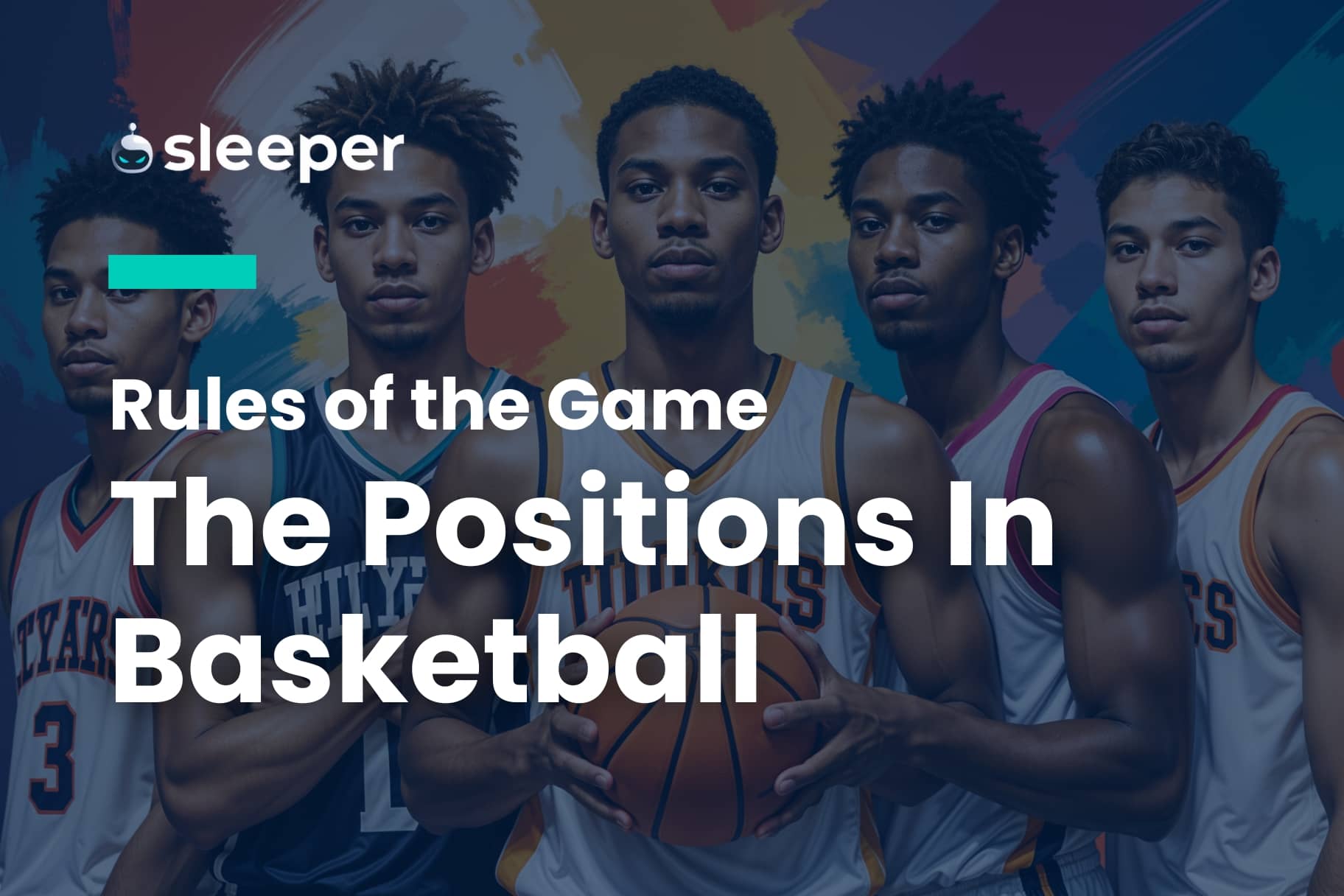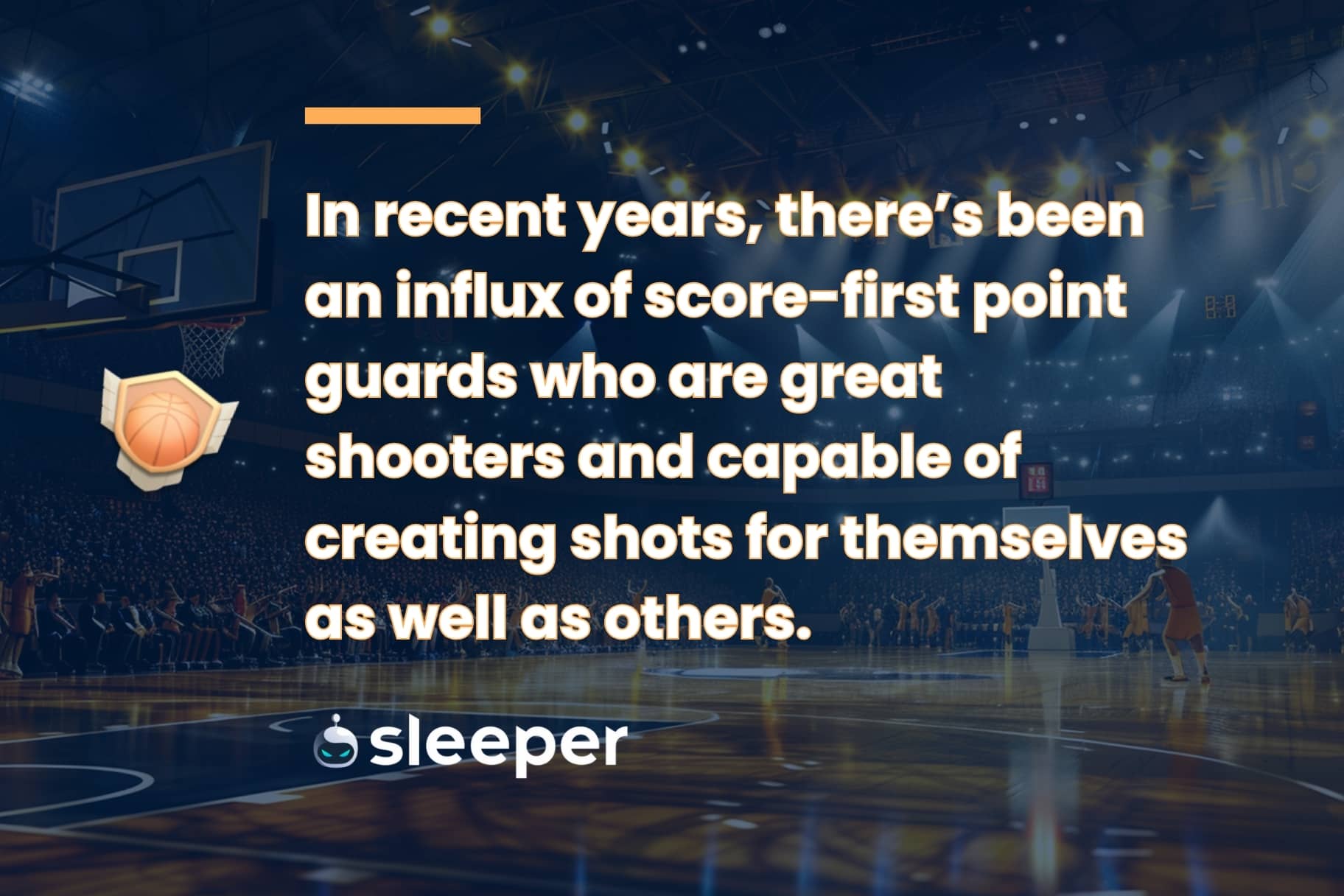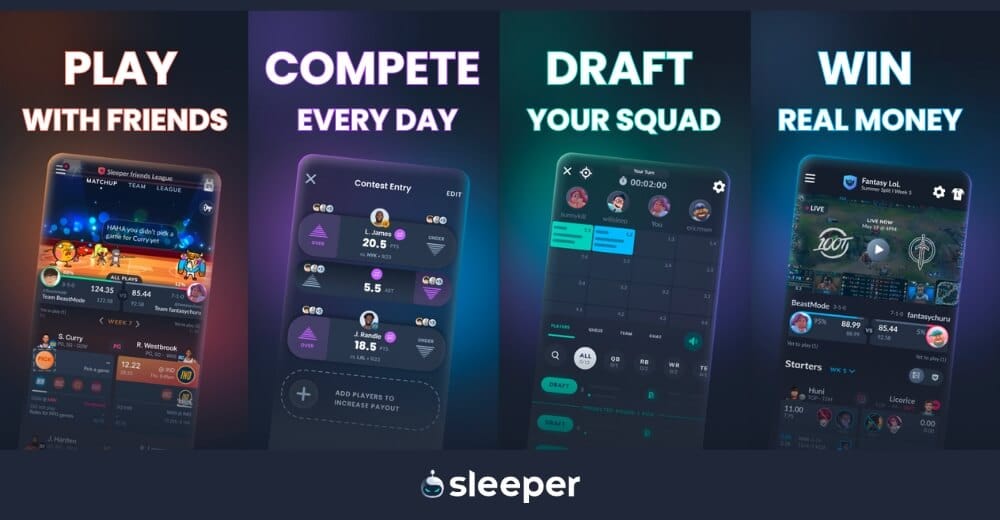If you’re just getting into basketball, use this guide to learn the various positions and what’s typically asked of each player on the court.

Understanding Positions in Basketball: What Are Their Roles?
If you’re just getting into basketball, it’s important to learn the positions and roles of each player on the court. If you’re a fantasy basketball manager, mastering lineup optimization and making strategic decisions based on player positions is crucial.
This article will provide an in-depth breakdown of each position, detailing the various roles, how they have evolved in recent years, the impact of positionless basketball, how you can apply this information to your fantasy lineup and more!
All Basketball Positions Explained
During a basketball game, each team has five players on the court at all times. Traditionally, these are the five positions on a basketball team:
- Point Guard (PG)
- Shooting Guard (SG)
- Small Forward (SF)
- Power Forward (PF)
- Center (C)
Each position has specific responsibilities, and the goal is for the five players to play off of one another and complement each other’s skill sets. Let’s delve into what has traditionally been expected of each position.
Point Guard
Point guards bring the ball up the court, run the offense, set the tempo and try to set up teammates for easy baskets. They are sometimes called the “floor general,” as they communicate with the coaches, call plays and direct the action.
Traditionally, the skills associated with a point guard are passing, dribbling, court vision, speed, unselfishness, high basketball IQ and leadership. In today’s NBA, Indiana Pacers superstar Tyrese Haliburton is a great example of a traditional point guard, as he’s a pass-first facilitator with exceptional court vision (he led the NBA in assists per game in 2023-24 with 10.9) and constantly makes the right play while helping his teammates score easy baskets. He’s also terrific at starting the fastbreak and attacking in transition.
In recent years, there’s been an influx of score-first point guards who are great shooters and capable of creating shots for themselves as well as others. However, when most people think of a point guard, they tend to picture a pass-first player who is essentially the team’s quarterback.
On defense, point guards are once again in charge of communicating with the coaches, calling out schemes, pointing out assignments and leading the team. They are also tasked with picking up the other team’s ball-handler as they bring the ball up and set up their offense, sometimes doing so the length of the court (a full-court press).
Point guards are typically the smallest players on the team. Some teams prefer putting a taller player at point guard to cause matchup problems on both ends of the floor. But as of 2022, the average NBA point guard was 6 feet, 2.5 inches – the shortest of the five positions.

Shooting Guard
Just as the name suggests, the shooting guard is typically asked to shoot the ball and be a primary scoring option for the team. Three-point shooting is extremely important in today's NBA, so it's crucial to have a shooting guard who can nail a high percentage from beyond the arc.
Some shooting guards score from everywhere on the court and have no problem creating their own shots (like James Harden, for example). Others thrive off-ball, knocking down catch-and-shoot opportunities and shooting after coming off of screens (like Klay Thompson).
On defense, the shooting guard provides perimeter defense, contests three-point shots, plays the passing lanes and works with the point guard.
Typically, shooting guards are slightly taller than point guards; in 2022, the average NBA shooting guard was 6 feet, 4.5 inches.
Small Forward
Small forwards play on the wing and must have a versatile skill set. They typically do a little bit of everything while moving back and forth from the perimeter to the interior.
On offense, they are expected to be able to score the ball, knock down threes, facilitate ball movement, shoot coming off screens, crash the glass for offensive rebounds and more. On defense, they use their size and length to contest and block shots, play the passing lanes, rebound and guard multiple positions.
An example of a prototypical small forward is LeBron James, who can dominate inside and out on both ends of the court. He’s about three inches taller than the average NBA small forward, which in 2022 measured at 6 feet, 6.4 inches.
Power Forward
For many years, power forwards played close to the basket and focused on rebounding, scoring in the low post, blocking shots and doing the dirty work.
In today’s NBA, teams value power forwards who can defend and rebound but also shoot threes. Power forwards whose shooting range extends out to the three-point line are called “stretch 4s,” and they are highly coveted by NBA front offices who value shooting and spacing.
Power forwards are typically the second-tallest player on the team, behind only the center. In 2022, the average NBA power forward was 6 feet, 8.5 inches.
San Antonio Spurs legend Tim Duncan is an example of a traditional power forward, while Utah Jazz star Lauri Markkanen is an example of a modern "stretch 4."
Center
Traditionally, centers play close to the basket and focus on protecting the rim, grabbing rebounds, setting screens and scoring in the paint. They serve as the team’s interior presence, ensuring that opponents can’t get easy points near the basket.
The center is typically the tallest player on the team; in 2022, the average NBA center was 6 feet, 11 inches (and there are many over 7 feet).
At one point, centers dominated the NBA – with pretty much every offense running through the towering low-post scorers.
Los Angeles Lakers legends Kareem Abdul-Jabbar and Shaquille O’Neal are examples of traditional centers who were virtually unstoppable in the paint during their playing days.
In the modern NBA, many teams want their centers to be able to shoot from three-point range and serve as a “stretch 5.” Milwaukee Bucks center Brook Lopez and Pacers center Myles Turner are examples of that, as they are asked to protect the rim on defense and then knock down threes on offense.
On the flip side, some teams opt for small-ball centers like Golden State Warriors star Draymond Green or New Orleans Pelicans star Zion Williamson in order to create matchup problems.
See also: Basic Rules of Basketball
What Are The Positions in Fantasy Basketball?
In fantasy basketball, the positions are a little bit different. Entering a fantasy basketball draft, you are trying to fill out your roster, which typically consists of the following positions:
- PG
- SG
- G
- SF
- PF
- F
- C
- C
- UTIL
- UTIL
- BN
- BN
- BN
- IL
While fantasy basketball features the traditional positions that we’ve covered, they also have a guard slot where you can play any point guard or shooting guard; a forward slot where you can play any small forward or power forward; a utility slot where you can play any player; and bench spots for depth at any position. The IL (injured list) slot allows managers to stash an extra player who is hurt without taking up space on the active roster.
Many NBA players are eligible to be used at two or three positions in fantasy basketball. For example, LeBron is listed as a SF/PF/C on Sleeper. This is pretty common since many players receive minutes across several positions throughout the season.
Further reading: How Does Fantasy Basketball Work?
Why Are Basketball Positions Referred To As Numbers?
While watching a basketball game, you might hear a broadcaster use numbers to refer to the various positions, but that does not correlate to players’ jersey numbers. This is just shorthand that players, coaches and announcers often use to be concise and communicate quickly. When a coach calls a play in the huddle, for instance, it’s just easier to shout the numbers than say the position.
Here are the positions and their designated numbers:
- Point Guard: 1
- Shooting Guard: 2
- Small Forward: 3
- Power Forward: 4
- Center: 5
How Positionless Basketball Is Changing Things
In today’s NBA, "positionless basketball" is taking over. Teams are focusing less on the traditional positions and more on playing their five best players together. Some coaches have stopped using the traditional positions altogether, instead separating their players into three categories: guards, wings and bigs.
For decades, if a player didn’t have a specific position they thrived at, they were labeled a “tweener” (since they were stuck between two positions), and they would often slip in the NBA Draft as a result. Coaches weren’t sure how to use these players, and the fear was that they would be a defensive liability because they lacked prototypical size or length.
However, in the 2010s, everything changed when small-ball and positionless basketball took off. Players who were previously criticized for being tweeners were suddenly being lauded for their versatility. Now, if a player can play (and defend) multiple positions, they are in high demand.
If you turn on an NBA game nowadays, it can be tough to pick out the individual positions at times, as they are often interchangeable and teams just want their best players on the court.
Basketball Positions: Frequently Asked Questions
Which position gets paid the most money?
For many years, point guards were the lowest-paid players on an NBA team and centers took home the big bucks. However, with many of today’s point guards emerging as primary scoring options and marketable superstars, they are now the highest-paid among the five positions.
According to Spotrac, the average salaries by position during the 2023-24 NBA season were:
- Point Guard: $11.8 million
- Shooting Guard: $8.9 million
- Small Forward: $8.5 million
- Power Forward: $9.9 million
- Center: $9.4 million
What is a sixth man?
The term “sixth man” doesn’t have anything to do with basketball positions. Each team has a starting five, and then the sixth man is the first player who checks in off the bench.
Traditionally, the most notable sixth men have been scoring guards who can create instant offense (like three-time Sixth Man of the Year winners Jamal Crawford and Lou Williams).
How many players are on an NBA team?
During the NBA offseason, teams can carry as many as 21 players on their roster; however, during the regular season, the maximum number of players is 15.
Teams are also allowed to have three players on two-way contracts. Those players split time between the NBA team and the club's G League affiliate (essentially the NBA's minor league).
Dominate Fantasy Basketball With Sleeper
If you’re interested in starting a fantasy basketball league, there’s no better platform than Sleeper! Sleeper offers exclusive features like Lock-In mode, Game-Pick mode, voice and text chat, custom scoring, in-depth notes for research, custom playoff settings, no ads, multi-team trades, every type of league (including keeper and dynasty), weekly league reports, live scoring, each player's transaction history and much more.
Not only is Sleeper an excellent platform for season-long fantasy leagues, it’s also a great destination for DFS. With Sleeper Picks, you can multiply your winnings up to 100x with just a few selections, follow live gamecasts and chat with friends as you compete.




